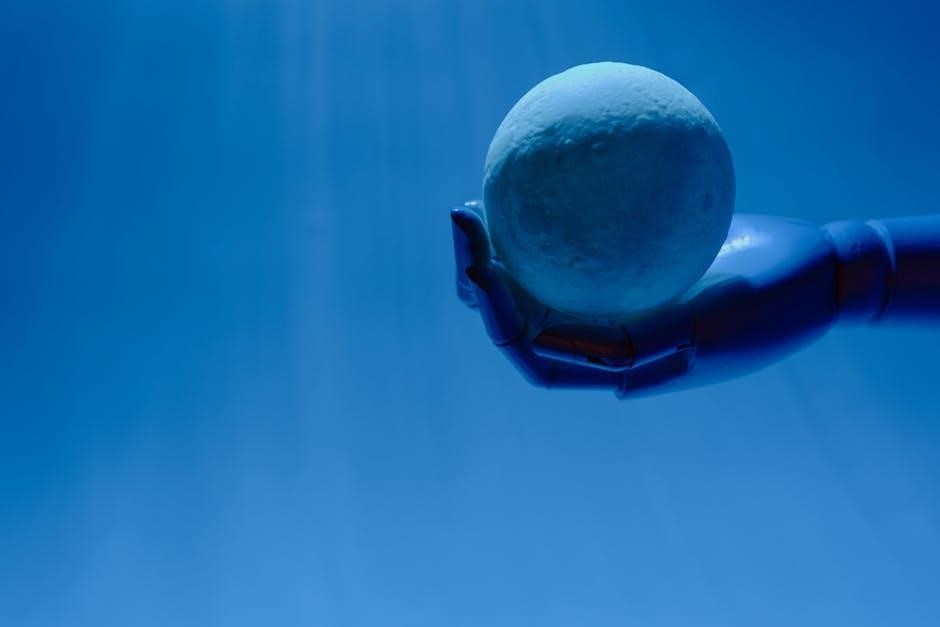
sprinkler system design pdf
Sprinkler systems are essential for fire suppression‚ agriculture‚ and landscape irrigation‚ ensuring water efficiency and safety․ Proper design involves hazard classification‚ water supply‚ and pipe sizing to meet NFPA standards and specific applications․
Overview of Sprinkler Systems
Sprinkler systems are networks of pipes and sprinklers designed to distribute water efficiently for various applications‚ including fire suppression‚ agricultural irrigation‚ and landscape watering․ These systems are tailored to specific needs‚ such as frost protection‚ cooling‚ or fertilization application․ They can be permanent or temporary‚ with designs like hose-pull systems for flexibility․ Modern systems incorporate advanced components like rotors and nozzles to optimize water usage and coverage․ Proper design ensures even distribution‚ preventing overwatering or dry spots․ Guidelines often reference standards like NFPA 13 for fire systems‚ emphasizing water supply‚ hazard classification‚ and installation practices․ Whether for residential‚ commercial‚ or agricultural use‚ sprinkler systems play a critical role in water management and safety‚ offering reliable solutions for diverse environments․
Importance of Proper Design
Proper design is critical for sprinkler systems to ensure efficiency‚ safety‚ and effectiveness․ A well-designed system optimizes water distribution‚ reducing waste and ensuring adequate coverage․ In fire suppression‚ it guarantees reliable operation during emergencies; For irrigation‚ it prevents overwatering and nutrient leaching‚ promoting healthy plant growth․ Proper design also considers factors like water pressure‚ pipe sizing‚ and hazard classification‚ aligning with standards such as NFPA 13․ Incorrect designs can lead to system failures‚ increased costs‚ or environmental damage․ Thus‚ careful planning and adherence to guidelines are essential to maximize system performance and longevity‚ ensuring it meets its intended purpose effectively․
Key Considerations in Sprinkler System Design
Key considerations include assessing water supply‚ pressure requirements‚ and hazard classification․ Proper pipe sizing‚ system layout‚ and compliance with NFPA standards ensure efficiency‚ safety‚ and reliability in fire suppression and irrigation systems․
Water Supply and Pressure Requirements
A reliable water supply is critical for sprinkler systems to function effectively․ The design must ensure adequate water pressure and flow rate to meet the system’s demands․ NFPA standards provide guidelines for evaluating water sources‚ such as municipal supplies‚ wells‚ or reservoirs․ Pressure requirements vary depending on the system’s application‚ whether for fire suppression or irrigation․ Hydraulic calculations are essential to determine the necessary pressure and flow rates at each sprinkler head․ Factors like pipe friction‚ elevation changes‚ and valve losses must be considered to maintain optimal pressure throughout the system․ Additionally‚ the water supply must be sufficient to handle peak demand scenarios‚ such as simultaneous sprinkler activation in fire suppression systems․ Proper sizing of pipes and pumps ensures that water pressure remains consistent‚ even in large or complex systems․ Regular testing and maintenance are also crucial to verify that the water supply and pressure meet design specifications over time․
Hazard Classification and Risk Assessment
Hazard classification is a critical step in sprinkler system design‚ ensuring that systems are tailored to specific fire risks․ Buildings are categorized into hazard levels—Light Hazard‚ Ordinary Hazard‚ or High Hazard—based on factors like occupancy‚ combustible materials‚ and fire potential․ NFPA standards provide detailed guidelines for these classifications․ Risk assessment involves identifying potential fire hazards‚ such as flammable liquids‚ electrical equipment‚ or high-pile storage‚ and determining the appropriate sprinkler density and spacing․ This process ensures that the system can effectively suppress or extinguish fires in different scenarios․ Accurate hazard classification and risk assessment are essential for balancing safety‚ cost‚ and system performance․ They also help in selecting the right sprinkler types‚ such as standard spray‚ extended coverage‚ or special hazards sprinklers․ Proper assessment ensures that the sprinkler system meets local fire codes and protects lives and property effectively․
System Layout and Pipe Sizing
A well-designed sprinkler system layout ensures efficient water distribution and even coverage․ Pipe sizing is critical to maintain adequate water pressure and flow rates‚ minimizing friction loss․ Hydraulic calculations determine the optimal pipe diameters based on water supply‚ pressure‚ and system demand․ Proper layout considers obstacles‚ building geometry‚ and sprinkler spacing to ensure complete coverage․ NFPA standards provide guidelines for pipe sizing and layout to meet fire suppression or irrigation needs․ Balancing system performance with cost is essential․ Advanced software tools can aid in designing efficient layouts and sizing pipes accurately․ Regular maintenance ensures the system operates as intended․ Proper system layout and pipe sizing are vital for reliability and effectiveness in fire suppression or irrigation applications․ Adherence to design standards ensures safety‚ efficiency‚ and compliance with local regulations․
Components of a Sprinkler System
A sprinkler system consists of several key components designed to ensure efficient water distribution․ The water source provides the supply‚ which could be a municipal connection‚ well‚ or reservoir․ Pumps are used to increase water pressure if the natural supply is insufficient․ Distribution pipes carry water from the source to the sprinklers‚ with sizes varying based on system requirements․ Sprinkler heads are the endpoints that discharge water in a predetermined pattern‚ available in fixed‚ rotator‚ or misting types․ Control systems‚ including valves and timers‚ regulate water flow and activation․ Additional components like filters‚ pressure regulators‚ and alarms enhance system performance and safety․ Each part must be selected and installed correctly to ensure the system operates efficiently and reliably․ Proper component selection is vital for achieving desired irrigation or fire suppression outcomes․

Design Steps for an Effective Sprinkler System
Designing an effective sprinkler system involves a systematic approach to ensure functionality‚ efficiency‚ and safety․ First‚ assess the site requirements‚ including water supply and pressure․ Next‚ classify the hazard level to determine the appropriate sprinkler density․ Select sprinkler types based on the application‚ such as commercial or agricultural use․ Develop a system layout‚ considering pipe sizing and routing to minimize pressure loss․ Use hydraulic calculations to ensure adequate water distribution․ Integrate control systems for automation and monitoring․ Finally‚ test the system to verify performance and make adjustments․ Regular maintenance is essential to sustain efficiency and reliability․ Adhering to standards like NFPA 13 ensures compliance and optimal system design․ Proper planning and execution are critical to achieving a sprinkler system that meets its intended purpose effectively․ Each step requires careful consideration to deliver a robust and reliable solution․

Hydraulic Calculations and Pipe Sizing
Hydraulic calculations are essential for ensuring that a sprinkler system operates efficiently‚ delivering the correct water pressure and flow rate to each sprinkler head․ These calculations help in designing a system that meets the specific needs of the area being irrigated or protected․ Factors such as water supply‚ pipe material‚ and friction loss must be carefully considered to ensure optimal system performance․ Pipe sizing is critical to ensure that water is distributed evenly and efficiently throughout the system․ Using specialized software or hydraulic calculation methods‚ designers can determine the appropriate pipe sizes and layout to minimize pressure losses and ensure adequate water supply to all parts of the system․ Accurate hydraulic calculations and proper pipe sizing are vital for the effective operation of a sprinkler system‚ ensuring reliability and efficiency in fire suppression or irrigation applications․
System Installation and Testing
Proper installation and testing of a sprinkler system are critical to ensure its effectiveness and reliability․ The installation process involves placing sprinkler heads‚ pipes‚ and control valves according to the designed layout․ It is essential to follow manufacturer guidelines and local safety codes to avoid system failures․ After installation‚ thorough testing is required to verify that all components function correctly․ This includes checking for leaks‚ ensuring proper water pressure‚ and testing the activation of sprinkler heads․ Additionally‚ the system should be inspected to confirm that it meets the design specifications and hazard classifications․ Regular testing and maintenance are recommended to ensure the system remains operational over time․ Proper installation and testing are the final steps in creating a reliable sprinkler system‚ whether for fire suppression or irrigation purposes․
Maintenance and Servicing
Regular maintenance and servicing are crucial to ensure the longevity and efficiency of a sprinkler system․ This includes inspecting pipes for leaks‚ cleaning sprinkler heads‚ and checking valves for proper function․ Servicing should be performed seasonally to adapt to changing conditions‚ such as winterizing the system to prevent freezing․ Additionally‚ maintaining accurate records of inspections and repairs helps track system performance over time․ Proper maintenance not only prevents unexpected failures but also ensures that the system operates optimally‚ conserving water and reducing costs․ Regular servicing by qualified professionals is recommended to identify and address potential issues before they escalate․ By prioritizing maintenance‚ the sprinkler system remains reliable and effective in fulfilling its intended purpose‚ whether for irrigation or fire suppression․

Case Studies and Best Practices
Case studies highlight successful sprinkler system designs across various applications‚ from fire suppression to agricultural irrigation․ For instance‚ a frost protection system in an orchard utilized properly spaced sprinklers to maintain soil moisture‚ preventing crop damage․ Best practices include adhering to NFPA 13 standards for fire systems and conducting thorough risk assessments․ In commercial settings‚ integrating sprinklers with fire alarms enhances safety․ Agricultural projects benefit from soil moisture monitoring to optimize water usage․ Regular inspections and maintenance are critical‚ as seen in a study where timely repairs prevented system failures․ Design guides‚ like the MP Rotator Design Guide‚ provide actionable insights for efficient layouts․ Prioritizing water conservation and adapting designs to local conditions ensure long-term system efficiency․ These examples underscore the importance of tailored designs and ongoing servicing to achieve optimal performance and safety in sprinkler systems․
Software Tools for Sprinkler System Design
Modern sprinkler system design relies heavily on advanced software tools to ensure accuracy and efficiency․ Programs like Toro’s Sprinkler Design Service and the MP Rotator Design Guide provide comprehensive solutions for creating tailored irrigation and fire suppression systems․ These tools allow designers to input specific parameters such as water supply‚ hazard classification‚ and soil types to generate optimal layouts․ Hydraulic modeling software enables precise calculations for pipe sizing and flow rates‚ ensuring proper system performance․ Additionally‚ 3D modeling capabilities help visualize installations‚ reducing potential conflicts with existing infrastructure․ Many software solutions also incorporate best practices and adhere to NFPA standards‚ streamlining compliance․ Regular updates and technical support further enhance their utility․ By leveraging these tools‚ professionals can design systems that are not only effective but also cost-efficient and environmentally friendly‚ meeting the diverse needs of residential‚ commercial‚ and agricultural applications․ These resources have become indispensable in the sprinkler system design process․

Cost Estimation and Budgeting
Accurate cost estimation and budgeting are crucial for successful sprinkler system design and implementation․ Factors such as water supply requirements‚ pipe sizing‚ and system layout significantly influence expenses․ Initial installation costs include materials like pipes‚ sprinklers‚ and control valves‚ while long-term expenses involve maintenance‚ repairs‚ and water usage․ Designing systems that balance performance and affordability is essential‚ as overly complex designs can escalate costs without adding value․ Budgeting should also account for potential upgrades or expansions․ Tools like Toro’s design service and NFPA guidelines can help optimize resource allocation․ Proper financial planning ensures that the system meets functional needs while staying within budget constraints‚ making it a critical step in the design process․ Regular cost assessments and comparisons with industry standards can further refine budgeting strategies‚ ensuring efficient use of resources․ This approach guarantees that sprinkler systems are both effective and economically viable for their intended applications․